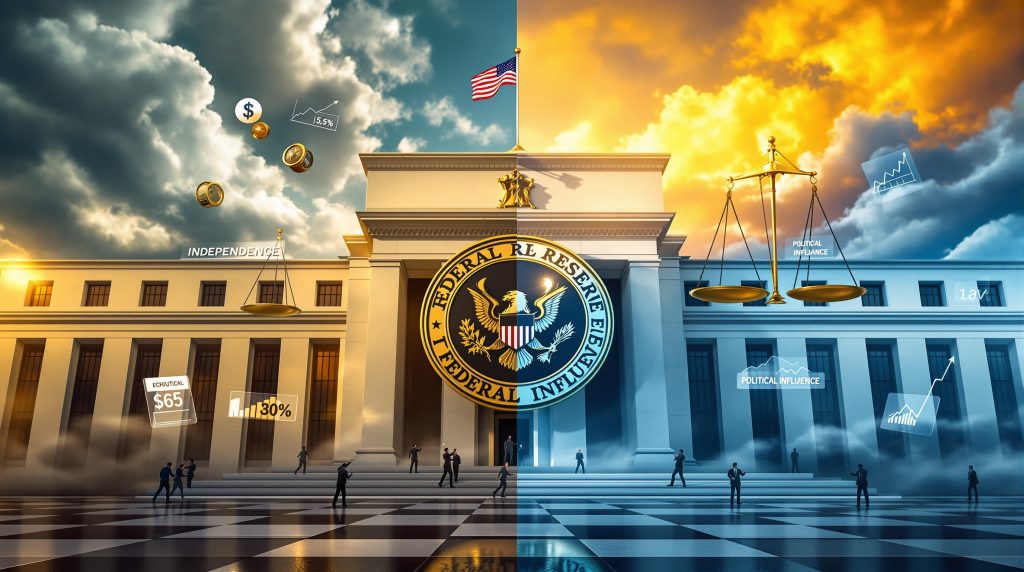How Has the Relationship Between Politics and the Federal Reserve Evolved?
The relationship between politics and monetary policy has undergone significant transformation over decades, with the Federal Reserve's independence constantly being tested and redefined. This evolution began notably during Alan Greenspan's tenure as chairman and continued through subsequent chairs, progressively blurring the lines between monetary policy and political considerations.
This gradual erosion represents a significant shift from the institutional independence originally designed to insulate monetary policy from short-term political pressures. Understanding this historical progression provides essential context for evaluating current tensions between the executive branch and the Federal Reserve, especially in light of recent US economic pressures.
The Historical Foundation of Fed Independence
The Federal Reserve System was deliberately structured with specific safeguards to maintain independence from direct political control:
- 14-year terms for Fed governors ensure no single administration can reshape the entire board
- Staggered appointment schedules prevent concentrated political influence
- The Federal Reserve Act of 1913 established clear separation between monetary and fiscal authorities
- Chairperson terms extending beyond presidential administrations create continuity
The building housing the Federal Reserve Board—the Eccles Building—is named for Marriner Eccles, who demonstrated this independence when he completed his full 14-year term despite significant pressure from President Truman in 1948. This historical example illustrates how the system was designed to withstand political influence even in its early decades.
These structural protections weren't arbitrary—they were specifically implemented to prevent monetary policy from becoming a tool for political expediency rather than economic stability, recognizing that political cycles often create incentives that conflict with sound monetary management.
What Threatens Fed Independence Today?
Executive Branch Pressure
Recent years have witnessed unprecedented public criticism of Federal Reserve leadership by the executive branch. This pressure manifests in several concerning ways:
- Public statements directly criticizing interest rate decisions
- Personal attacks questioning Fed leadership qualifications and competence
- Suggestions of removing or replacing officials who don't align with administration priorities
- Direct calls for specific monetary policies that may benefit short-term political objectives
This external pressure creates a challenging environment for Fed officials attempting to make data-driven decisions independent of political considerations. The increased frequency and intensity of these criticisms represent a departure from traditional norms of respecting central bank independence.
Internal Political Calculations
The threat to independence isn't solely external. Some critics argue that Fed officials themselves have compromised independence by:
- Allowing political pressure to influence decision-making beyond what economic data would suggest
- Making decisions that appear motivated by personal or institutional self-preservation
- Responding to criticism by either capitulating or overcorrecting in opposition
- Failing to maintain consistent, transparent communication about policy rationales
For the first time in nearly two decades, the Federal Reserve has experienced a "double dissent" from governors, indicating growing internal divisions that may reflect different responses to political pressure. This internal erosion of independence may be more difficult to address than external pressure, as it involves institutional culture and individual decision-making processes.
How Does the Appointment Process Impact Fed Independence?
The Challenge of "Stacking" the Fed
The structure of the Federal Reserve creates inherent limitations on any administration's ability to rapidly reshape monetary policy through appointments:
- Governors serve 14-year terms, significantly limiting turnover opportunities
- Regional bank presidents are selected through a separate process involving regional boards
- The chair position, while influential, represents just one vote on the Federal Open Market Committee
- Senate confirmation requirements provide additional scrutiny and potential constraint
These structural safeguards make "stacking the Fed" a difficult and time-consuming process. However, strategic appointments can gradually shift the balance of power within the Fed, particularly if appointees are selected primarily for their alignment with administration priorities rather than their economic expertise.
The Chair's Influence vs. Board Dynamics
While the Fed chair holds significant influence over policy direction and communication, the Federal Reserve operates as a committee:
- The FOMC consists of 17 individuals with voting rights
- Dissenting votes have become more common in recent years
- Staff economists and researchers provide substantial input and analysis
- Regional bank presidents bring diverse perspectives from different economic regions
This collective decision-making structure means that even a chair appointed to implement specific policies may face resistance from other board members and regional bank presidents if those policies don't align with their economic assessments. The system's design intentionally creates this tension to prevent any single individual from dominating monetary policy.
What Historical Parallels Exist for Today's Fed Challenges?
The Nixon-Burns Era Comparison
One of the most frequently cited historical parallels to current Fed independence concerns is the relationship between President Nixon and Fed Chair Arthur Burns:
- Burns was perceived as accommodating Nixon's political priorities, particularly around election timing
- Monetary policy decisions appeared influenced by political considerations rather than economic data
- The resulting policies contributed to the significant inflation of the 1970s
- Paul Volcker was eventually tasked with implementing painful inflation-fighting measures
This historical example demonstrates the potential long-term economic consequences when monetary policy becomes subordinated to political objectives, particularly around election cycles. The inflation that followed required years of high interest rates and economic pain to resolve.
The Volcker Era Mutiny
Even Paul Volcker, widely regarded as a paragon of Fed independence, faced significant internal resistance:
- Board members eventually rebelled against his tight monetary policy
- The economic pain caused by high interest rates created intense political pressure
- Volcker maintained his anti-inflation stance despite this opposition
- His policies ultimately succeeded in taming inflation but at significant short-term economic cost
This historical precedent illustrates both the importance of Fed independence and the reality that even strong chairs must navigate internal disagreement and external pressure. It also demonstrates that sometimes unpopular monetary policy decisions prove correct in the long run, even when they face resistance in the moment.
How Do Politics Impact Inflation Management?
The Political Challenge of Fighting Inflation
Managing inflation often requires politically unpopular decisions:
- Rate increases can slow economic growth and employment in the short term
- Higher borrowing costs affect consumer spending, housing markets, and business investment
- Benefits of price stability are diffuse while costs are concentrated and immediate
- Election cycles create pressure for economic stimulus rather than restraint
These factors create natural tension between political incentives and sound monetary policy, particularly when inflation begins to accelerate. Politicians naturally prefer policies that produce immediate benefits with delayed costs, while effective inflation management often requires the opposite approach.
The Stimulus-Inflation Connection
Government fiscal policy significantly impacts the Fed's inflation management challenges:
- Pandemic-era stimulus programs injected trillions into the economy through direct payments
- Direct payments to households created substantial consumer spending power
- Supply chain disruptions amplified price pressures from increased demand
- The Fed must counterbalance inflationary fiscal policy with monetary tightening
Recent core Consumer Price Index readings of 3.1% year-over-year (with 54% of increases attributable to shelter inflation) reflect the lingering effects of this fiscal-monetary dynamic. This relationship highlights how political decisions about government spending create conditions that the Fed must then address through monetary policy, often leading to tension between fiscal and monetary authorities.
What Data Quality Issues Complicate Fed Decision-Making?
Labor Market Data Reliability Concerns
Questions about the accuracy of government economic statistics add another layer of complexity to monetary policy decisions:
- Labor market data has experienced significant revisions in recent years
- 24 of 30 recent monthly jobs reports were subsequently revised downward
- Full-time job losses may be masked by growth in part-time and gig employment
- 89% of economists have expressed doubts about labor statistics quality
Recent data showing 440,000 full-time jobs lost in a single month raises serious questions about labor market strength. These data quality issues make it extremely difficult for the Fed to accurately assess economic conditions, potentially leading to policy errors based on flawed information.
The Shelter Inflation Challenge
Housing costs represent a particular challenge for inflation measurement:
- Shelter costs account for approximately one-third of the Consumer Price Index
- Housing market indicators often lag actual market conditions by several months
- In recent reports, shelter inflation contributed 54% of core CPI increases
- Private sector housing data from sources like Redfin and CoreLogic often show different trends than official statistics
This measurement challenge creates situations where the Fed may be responding to inflation data that doesn't accurately reflect current economic conditions, particularly in housing markets. The significant lag in official housing price data can lead to policy decisions that no longer match market realities.
What Are the Consequences of Zero Interest Rate Policy?
The Debt Trap Dilemma
Extended periods of extremely low interest rates create structural economic challenges:
- Companies and households become accustomed to and dependent on cheap borrowing
- Debt levels expand substantially during low-rate environments
- When rates eventually rise, this debt burden becomes increasingly difficult to service
- The economy becomes increasingly sensitive to even modest interest rate changes
This creates a "debt trap" where the Fed finds it increasingly difficult to normalize interest rates without causing significant economic disruption. The longer rates remain artificially low, the more difficult the eventual transition to normal rates becomes, further constraining monetary policy independence.
The Failed Experiment Perspective
Some critics view the zero interest rate policy (ZIRP) and quantitative easing as fundamentally flawed approaches:
- These tools were deployed as emergency measures but became normalized over time
- They may have contributed to asset bubbles and wealth inequality
- Financial markets became dependent on Fed support rather than economic fundamentals
- The long-term consequences remain uncertain and potentially harmful
This perspective suggests that truly independent monetary policy would involve acknowledging these programs as failed experiments rather than standard tools, regardless of political pressure to maintain accommodative policies. A mature approach would recognize that returning to zero rates would repeat past mistakes rather than solve current problems.
How Could Fed Independence Be Fundamentally Altered?
The Treasury Department Absorption Scenario
Some have speculated about more radical changes to Fed independence:
- Potential legislative action to bring the Fed under Treasury Department control
- Elimination of the separation between monetary and fiscal policy
- Direct monetization of government debt becoming standard practice
- Political control over interest rates and money creation
While requiring congressional action rather than executive order (as the Fed was established by the Federal Reserve Act of 1913), such fundamental restructuring would represent the complete abandonment of independent monetary policy in favor of politically directed economic management.
During the pandemic, some argue a version of this scenario temporarily occurred when the Treasury effectively "performed a leveraged buyout of the Fed," as pandemic emergency measures led to unprecedented coordination between fiscal and monetary authorities.
The Modern Monetary Theory Connection
Proposals to fundamentally alter Fed independence often align with Modern Monetary Theory (MMT) perspectives:
- MMT advocates argue for closer coordination between fiscal and monetary policy
- This approach would diminish traditional Fed independence by design
- Political rather than technocratic decisions would guide monetary policy
- The value of the dollar could be significantly impacted by this policy shift
This connection highlights how debates about Fed independence intersect with broader economic philosophy questions about the proper relationship between government and monetary systems. The "horseshoe theory" of political ideologies suggests that populist movements from both right and left might converge on similar approaches to monetary policy despite different starting points.
What Are the Implications for Global Financial Markets?
Dollar Reserve Status Concerns
Erosion of Fed independence raises serious questions about the dollar's global reserve currency status:
- International confidence in the dollar depends partly on Fed credibility and independence
- Political interference could undermine this confidence among global investors and central banks
- Other central banks might diversify reserves away from dollar assets to reduce risk
- Gold as an inflation hedge becomes more attractive when central bank credibility is questioned
Gold has reportedly displaced the euro as the second most common reserve asset held by central banks, potentially signaling changing attitudes toward the dollar's reliability. These concerns highlight the international dimensions of Fed independence debates, as changes to the Fed's status could have far-reaching implications for global financial markets.
Gold as a Monetary Signal
Central bank gold accumulation may reflect changing attitudes toward monetary stability:
- Gold has displaced the euro as the second most common reserve asset for many central banks
- Central banks have added significant gold reserves in recent years
- This trend may signal concerns about fiat currency stability in general
- Historical patterns show increased gold reserves often coincide with geopolitical uncertainty
While multiple factors drive central bank gold purchases, the trend raises questions about confidence in the current monetary system and the Fed's role within it. From a historical perspective, significant gold accumulation by central banks has sometimes preceded periods of geopolitical instability, which is also reflected in recent gold prices analysis.
How Does Economic Uncertainty Impact Private Sector Decision-Making?
Capital Expenditure Paralysis
Political uncertainty surrounding monetary policy creates serious challenges for business planning:
- Companies struggle to make long-term investment decisions amid policy uncertainty
- Capital expenditure decisions get delayed or canceled entirely
- Hiring plans become more conservative and focused on short-term needs
- Cost-cutting takes precedence over expansion and growth initiatives
This "uncertainty tax" on the economy represents a significant but often overlooked cost of politicized monetary policy, as businesses adopt a wait-and-see approach rather than investing in growth. The resulting economic drag can be substantial even before actual policy changes occur.
Manufacturing Reshoring Challenges
Policy uncertainty particularly impacts manufacturing investment decisions:
- Reshoring manufacturing requires multi-year planning horizons for facility construction
- Sudden tariffs and market impact creates immediate cost pressures without time for adjustment
- Companies need policy predictability to justify major capital investments
- Uncertainty favors maintaining existing supply chains over creating new domestic capacity
Treasury Secretary Bessant himself acknowledged before taking office that companies need "a few years" to build plants rather than facing immediate tariff impositions. This dynamic illustrates how monetary policy uncertainty combines with trade policy uncertainty to create significant headwinds for domestic manufacturing growth.
What Generational Factors Influence Monetary Policy Politics?
Millennial Economic Challenges
Younger generations face unique economic circumstances that shape their views on monetary policy:
- Millennial homeownership rates have declined approximately 9 percentage points since 2004
- Student loan debt burdens limit financial flexibility and purchasing power
- More young adults live with parents than at any time since the Great Depression
- These generations represent a powerful voting bloc with distinct economic interests
These demographic realities create political pressure for accommodative monetary policies that might benefit younger generations facing housing affordability challenges, potentially at the expense of price stability. The economic frustrations of younger voters could significantly influence monetary policy debates.
Generational Voting Power Shifts
Changing demographic voting patterns could significantly impact monetary policy politics:
- Millennials and Gen Z together comprise approximately 48.5% of eligible voters
- These generations have experienced different economic conditions than their predecessors
- Their voting preferences could drive significant policy changes
- Economic frustration among younger voters could lead to support for more radical policy approaches
This demographic shift represents a significant wild card in predicting the future of Fed independence and monetary policy, as younger voters may have fundamentally different perspectives on the proper role of central banks based on their lived economic experiences.
How Can Fed Independence Be Preserved?
Institutional Courage Requirements
Preserving Fed independence in the current environment requires:
- Board members willing to dissent from politically expedient decisions
- Clear, consistent communication about policy rationales and economic data
- Transparency about data limitations and uncertainties
- Willingness to make unpopular decisions when economically necessary
This institutional courage becomes particularly important when facing direct political pressure from the executive branch or Congress. The history of the Fed shows that independence must sometimes be actively defended rather than passively assumed.
Addressing Data Quality Concerns
Improving economic data quality would strengthen the Fed's ability to make independent decisions:
- Enhanced labor market measurement methodologies that better capture changing work patterns
- Better real-time housing market indicators that reduce measurement lags
- Transparent acknowledgment of data limitations and revision patterns
- Integration of private sector data sources when appropriate to supplement official statistics
Better data would provide stronger foundations for policy decisions, making it easier for the Fed to justify its independence based on objective economic analysis rather than political considerations. When data quality is questionable, it becomes easier to dismiss Fed decisions as politically motivated rather than economically sound.
FAQ: Critical Questions About Fed Independence
How does the Fed chair appointment process work?
The Federal Reserve chair is nominated by the President and confirmed by the Senate for a four-year term. Importantly, the chair can only be removed for cause, not simply due to policy disagreements with the administration. The chair's term is deliberately staggered from presidential terms to reduce political influence.
Can the President fire the Fed chair?
No, the President cannot directly fire the Federal Reserve chair. Fed governors, including the chair, can only be removed "for cause," which has been legally interpreted to mean serious misconduct rather than policy disagreements. This protection is a crucial aspect of Fed independence.
How do interest rate decisions impact different economic groups?
Interest rate decisions have varying impacts across economic groups. Higher rates tend to benefit savers while increasing costs for borrowers. They can slow job growth, potentially harming lower-income workers, while helping control inflation that disproportionately impacts those same groups. This creates complex distributional effects that complicate monetary policy decisions.
What role does the Fed play during economic crises?
During economic crises, the Fed serves as both a lender of last resort to the financial system and implements monetary policy to stabilize the broader economy. These crisis roles often involve extraordinary measures that push the boundaries of traditional central banking, raising questions about appropriate limits on Fed powers.
How does Fed independence compare internationally?
The Federal Reserve has greater structural independence than many international counterparts, though less than the European Central Bank in some respects. International experience shows that central banks with greater political independence generally achieve better inflation outcomes over time, though with variations based on specific institutional arrangements.
Conclusion: The Delicate Balance of Monetary Independence
The independence of the Federal Reserve represents a delicate balance between democratic accountability and insulation from short-term political pressures. This balance faces significant challenges in today's polarized political environment, with both external pressure from elected officials and internal challenges within the Fed itself.
The historical record demonstrates that when monetary policy becomes subordinated to political objectives, the long-term economic consequences can be severe. Yet complete isolation from democratic oversight raises legitimate questions about technocratic power in a democratic system.
Finding the right balance requires institutional courage from Fed officials, respect for the Fed's independence from elected officials, and a shared commitment to transparent, data-driven decision-making focused on the Fed's dual mandate of price stability and maximum sustainable employment.
As political and economic uncertainties continue to mount, preserving this balance becomes increasingly challenging but ever more essential for long-term economic stability. The removal of policy uncertainty would allow businesses to make long-term investment decisions and potentially reinvigorate private sector growth—a goal that requires coordination between fiscal and monetary authorities while maintaining appropriate independence, especially as rising gold market trends signal continued economic concerns.
Want to Stay Ahead of Market-Moving Mining Discoveries?
Discovery Alert's proprietary Discovery IQ model instantly notifies subscribers of significant mineral discoveries on the ASX, providing actionable investment insights ahead of the wider market. Visit the discoveries page to understand how major mineral discoveries have historically generated substantial returns for early investors.




